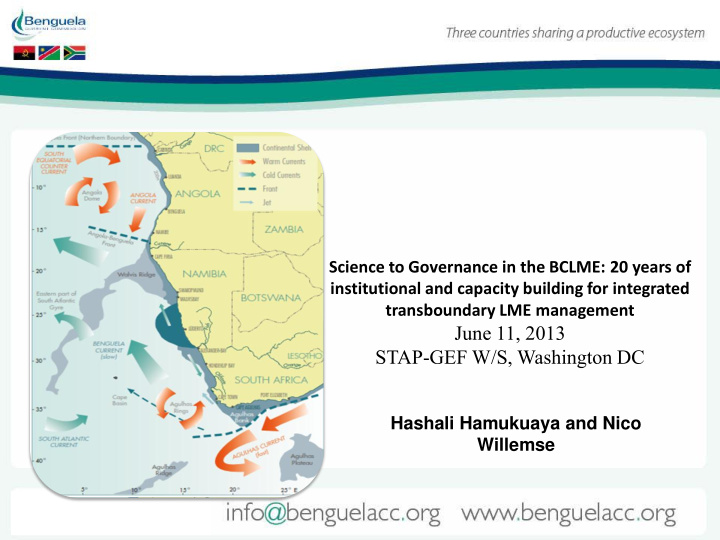



Science to Governance in the BCLME: 20 years of institutional and capacity building for integrated transboundary LME management June 11, 2013 STAP-GEF W/S, Washington DC Hashali Hamukuaya and Nico Willemse
TDA: Major Transboundary Issues Decline in commercial fish stocks Uncertain ecosystem status and yields Inadequate capacity to assess ecosystem Deterioration in water quality Habitat destruction and alteration Loss of biotic integrity and biodiversity Harmful algal blooms
SAP: Policy Actions Sustainable Management and Utilisation of Living Marine Resources Management of Mining and Drilling Impacts Oil and gas exploration and production Environmental Variability, Ecosystem Impacts and Improvement of Predictability Coastal Zone Management Maintenance of Ecosystem Health and Protection of Biodiversity Capacity strengthening Socio-economic and Governance *
• Annual monitoring and assessments of Sustainable commercial fish stocks through management and transboundary surveys use of LMRs • Assessment of interactions between shared demersal fish stocks in southern Angola and northern Namibia • Assessment of early history and stock identity for shared hake (Namibia and SA) and horse mackerel (Angola and Nam) • Annual overall stock assessment report – State of the Stocks Report published for 2012 • Joint Management Plans for horse mackerel • Regional Stock Assessment Working Group • EAF review of institutional capacities and ecological risk assessment of major species
• Minerals and Oil sector very instrumental during Convention text Management of development Mining and Drilling Activities • Scoping study for Strategic Environmental Assessment (SEA) of the BCLME completed, taking into account all marine sectors • Working Group on Minerals and Extractive Resources established • Private sector indicate strong interest for partnership – BCC Business Leadership Forum planned
Environmental • Environmental links to pelagic fish life variability, cycles, abundance and distribution: ecosystem impacts determining governing factors and improvements • Impacts of H 2 S and low oxygen on inshore of predictability marine species – mass mortalities and walk-outs recorded in the past SHBML Bottom Oxygen March 2000 - October 2006 • Understanding of the impacts of climate Concentration of dissolved oxygen 180 variability on the environment and on the 160 140 DISTANCE OFFSHORE (km) resources and on communities 120 100 • Collaboration with GOOS-Africa and ODIN 80 Africa improves access to high resolution 60 40 oceanographic data 20 0 Sep Mar Mar Sep Mar Sep Mar Sep Mar Sep Mar Sep Mar Sep 2000 2001 2002 2003 2004 2005 2006
Management of • Angola and Namibia at advanced pollution stages to accede to the Abidjan Convention • Closer collaboration established with IMO especially on regional oil spills contingency planning and regional Oil Spill Risk Assessment (OSRA) and sensitivity mapping
Maintenance of • Spatial biodiversity assessment and spatial ecosystem health management , including mapping of areas proposed for marine protected areas and protection of (MPAs) biodiversity • Development of acoustic methodology for zooplankton biomass assessment • Implementation of Continuous Plankton Recorder (CPR) survey in the BCLME – first cruise in August 2011 • Management planning for the Orange River Mouth estuary underway – collaboration with GEF IW Project on ORM
Training and capacity • BCC’s Training and Capacity Building (TCB) Strategy implemented since 2009 building • Training Policy adopted in 2012 • BCC TCB Advisory Group in established • Significant training and capacity building in each of the projects • Training offered in specialised fields e.g., Fish Stock Assessment, hydro-acoustic surveys, responsible fisheries and fisheries management • BCC supports various workshops and events where skills are exchanged about LME approach, ocean governance
• BCC Instruments • BCC Convention signed in March 2013. First multi- sectorial LME framework • Finance Policy, Personnel Policy and Procurement Policy, Data Policy adopted • Reviewing and updating of the TDA, SAP and Science Programme to be completed by August
• Structures and functions in place: Institutional Building • Ministerial Conference, • Management Board, • Ecosystem Advisory Committee (EAC), • Regional thematic working groups • The Secretariat
• Norway – BCC Science Programme • Iceland – BCC Training and Capacity Wider Cooperation Building Strategy • FAO EAF-Nansen Project – Implementation of EAF projects and on climate change vulnerability • Danish Technical University (DTU) and EU – improving stock assessment • ODIN Africa (improved data management) • ASCLME, GCLME and CCLME (African LME Caucus) – which is a network that collaborates on issues of common interest.
Concluding remarks: Where we are: - BCC is an established Commission with requisite structures and functions, due to: - Unwavering political will and support by the BCC Ministers - Support from GEF, other developing partners Where we are heading : - Finalising the updating of the TDA/ Strategic Action Programme - Sustainability of BCC – ensuring support to implement the Convention and thus scaling up “Science -to- Governance” - Establish partnerships with the private sector, academia and relevant organisations
Recommend
More recommend